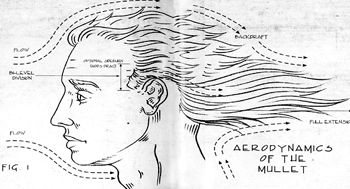![[Metroactive Features]](http://metroactive.com/features/gifs/feat468.gif)
[ Features Index | San Jose | Metroactive Central | Archives ]
Hair-Raising History
From Neanderthal man to the Beastie Boys, the legendary mullet boasts a long evolution with roots confused by its elusive etymology
By Mary Spicuzza
THE MULLET PHENOMENON proves once and for all that a visionary musical trio known as the Beastie Boys were cultural watchdogs far ahead of their time. Long before the web birthed its sites devoted to mullet mania, the Beasties released "Mullet Head," a 1994 B-side single celebrating the bad-hair legend of the '80s. Besides paying homage to bad hair legends like Joey Buttafuoco, Kenny G and Van Damme, Beastie Boys Mike D, AdRock and MCA even provide a mullet-making formula with the lyrics, "Number 1 on the side and don't touch the back/Number 6 on the top and don't cut it wack, Jack."
The Beastie Boys magazine, Grand Royal, also devoted an entire issue to bad hair, beginning with the prophetic words, "There's nothing quite as bad as a bad haircut. And perhaps the worst haircut of all is the cut we call 'The Mullet.'" And mullet history was made.
"A while back we got a letter from the Oxford English Dictionary saying that we had the first printed use of the word [to describe bad hair]," Grand Royal staffer Ian Rogers boasts.
Tracing the word doesn't help mullet hunters hoping to find origins of the look, with its nicknames ranging from "Missouri Compromise" and "Guido" to the "neck blanket." According to Webster's New World Dictionary, a mullet is "any of a family of edible, spiny-finned percoid fishes, both freshwater and marine, having a small mouth and feeble teeth." Nowhere is there a clause about these fish having short scales on top and long scales in the back.
Mark Larson, co-author of The Mullet: Hairstyle of the Gods, admits that the Beastie Boys were a major source of inspiration for his coffee table treasure. But Larson is looking beyond the band to find deeper roots of the bad hair legend. He agrees with slang lexicographers who see it as a cousin of "mullethead," 19th-century slang meaning "stupid, ignorant person." During the 1950s, slangsters abbreviated the insult to "mullet," meaning "fool."
After the '50s the slang evolution becomes far more complicated, but mulletologists agree that the 1960s were pivotal years in the development of the hairstyle and its description. James Lull, professor of communication studies at San Jose State University, says that the anti-establishment '60s took men's hair to new lengths of liberation.
"Nobody in the '50s would have worn hair like [the mullet]. You needed the Vietnam War to break open styles, and anyone with a conventional look was categorized as mainstream, a supporter of the war," Lull says. "Long hair was a separation from the mainstream. I think the mullet is a leftover from that."
He adds, "The mullet is also a protest look, standing outside of mainstream American corporate culture. Yet it's also very much a part of the mainstream. Who elected George W.? Probably a lot of mulletheads."
Hairstylist Emily Irby, owner of Emmy Mae's Beauty Parlor in Santa Cruz, remembers the mullet as part of San Jose cultural identity rather than a political statement.
"I remember the Valleys coming over to the Santa Cruz beaches with their lowriders and their mullets," she says. "If you even hung out with them, you just weren't cool."
Irby admits that the mullet has since dramatically evolved, and says that it is a popular cut among the San Francisco drag queen community for its easy stylability.
Devoted experts trace the mullet to centuries before the Summer of Love and drag shows, back to the days of Neanderthals. Mark Larson's book cites drawings depicting early Homo sapiens with their front hair short for better roaming and hunting visibility, and a long "neck blanket" to keep them warm through the cold prehistoric nights. He believes this explains evolutionary nicknames such as the "Ape Drape." Artists frequently depict ancient Egyptians, Celts, Vikings, saints and Jesus as mullets. (Mel Gibson wore a mullet in Braveheart). Larson thus concludes the mullet is a timeless look--one spanning centuries, races, economic groups and cultures of the world.
The Beastie Boys agree, and even attribute the dawn of the Dark Ages to a mullethead uprising. However, B-boys cohort The Captain admits, "To me, the mullet is as American as pickups with rifle racks, tractor pulls, Wal-Mart, wet T-shirt contests, slapping your girl upside the head with a frying pan and living in the woods."
A disturbing association, considering that scholars like Lull note that San Jose is "a hotbed of mullet presence."
None of the mullet experts can say for sure how the evolution of bad hair came together with obscure slang to provide the foundation for the mullet phenomenon. Still, like the union of peanut butter and chocolate, they agree that it has changed the world forever. Larson suspects the revival of mullet slang stems from Paul Newman's Cool Hand Luke, a 1967 film about a man who refuses to conform to life in a rural prison--and its bad hair. His small town foes are nicknamed "mulletheads."
Larson may do further research if his dreams of a mullet motion picture are realized. As for the Beastie Boys, they are busy working on future legend-making material.
"We're printing a mullet T-shirt, but that's about it," Royal's Rogers says. "But that song was back in the mid-'90s. We're over it, we're moving on."
[ San Jose | Metroactive Central | Archives ]
Copyright © 2001 Metro Publishing Inc. Metroactive is affiliated with the Boulevards Network.
For more information about the San Jose/Silicon Valley area, visit sanjose.com.
![]()

Illustration by Maria Burgaleta Larson, from 'The Mullet--Hairstyle of the Gods'
From the January 18-24, 2001 issue of Metro, Silicon Valley's Weekly Newspaper.